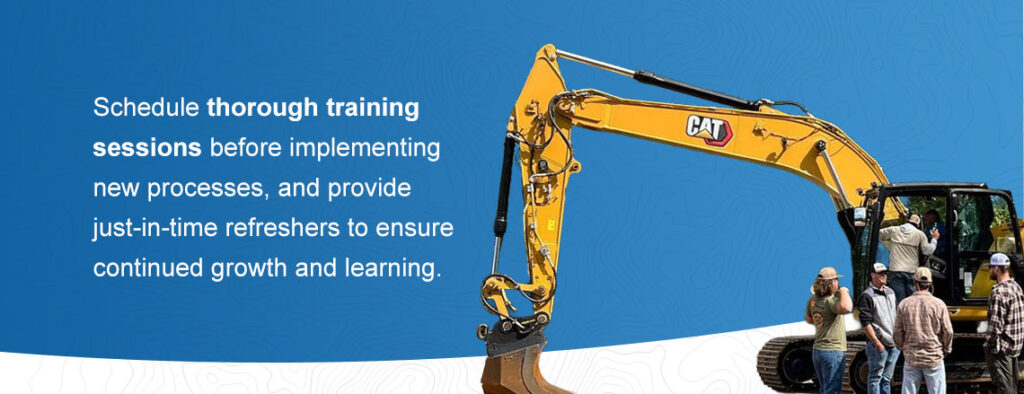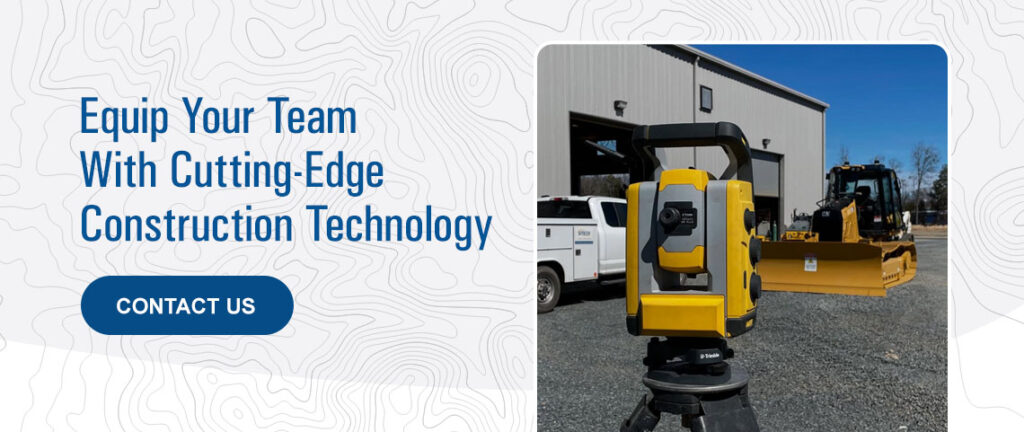New technology can boost productivity, efficiency and safety across your worksites, but getting workers on board can be a challenge. Construction crews may resist new systems and tools for various reasons, such as learning curves, mistrust or logistics. With the right approach and training, you can help your team embrace new technology and use it effectively.
How Technology Can Help the Construction Industry
Various types of heavy equipment technology can help your construction business in the following ways.
Productivity, Efficiency and Cost Savings
These technologies can help your team boost productivity and efficiency while reducing costs across projects:
- Automation: Drones and robots can handle high-risk or repetitive tasks, freeing human workers to focus on more complex jobs and increasing output.
- Artificial intelligence (AI): AI technology can analyze your company’s historical data, supply chain logistics and weather forecasts to create accurate, comprehensive project timelines.
- Machine control systems: Machine control systems use technologies such as sensors, lasers and GPS to guide heavy equipment. These systems automate tasks, guiding excavation and grading operations with enhanced precision.
- 3D modeling and digital blueprints: 3D modeling technology and digital blueprints help improve accuracy, reduce errors and help detect potential challenges early. This minimizes the need for rework and accelerates project completion times.
- Project management software: Project management software streamlines scheduling and communication between different teams within your business, preventing delays and facilitating smoother operations.
- Drones: Drones enable faster, easier surveying and progress monitoring. They can also help you deliver real-time updates to your clients.
Enhanced Safety

Automation, 3D modeling, drones and AI technology can also enhance safety. Deploying robots or drones on your worksites enables your team to complete tasks from a safe distance, letting the technology tackle challenging areas for them. AI algorithms can proactively detect risks, helping your workers protect themselves from accidents and injuries.
Sustainability
Modern technologies can also help you implement more sustainable, environmentally friendly practices. Energy-efficient equipment can help you reduce fuel consumption, and AI technology can help you optimize material usage to reduce waste.
Challenges of Technology Adoption in the Construction Industry
Workers may feel reluctant to try or implement new technology, but understanding their reservations can help you overcome this challenge. Here are some of the most common objections workers have when they resist adopting new technology:
- Job security or automation anxiety: Technology can feel like a threat to job roles or hours. Your team may need reassurance that new technology is a tool to enhance their job, not take it from them.
- Worries about loss of autonomy or craft: Some workers may feel like advanced tools deskill their craftsmanship or take away their ability to make hands-on judgment.
- Learning curves: Learning how to use a new technology can feel challenging. Equipment operators may need time, training and encouragement to feel comfortable using advanced tools.
- Trust and accuracy: Workers want to know that new technology is as accurate and dependable as their current methods. Workers may also want proof that new technology can operate reliably in tough conditions such as rain, mud, dust and extreme temperatures.
- Ergonomics and usability: Complex menus, touch screens and small fonts can be challenging to use when wearing PPE. Workers must adjust to switching between performing manual tasks and operating technology.
- Short-term productivity dips: Implementing new technology while meeting strict deadlines may cause additional stress. Workers need time to learn and experiment without the pressure of completing tasks quickly.
- Power and battery logistics: Sensors, drones, rovers and tablets require frequent charging. Workers may worry about having easy power access on remote sites.
- Extra steps: Technology can add steps and challenges to tasks depending on how workers use it. Training operators on how to use new tools and programs efficiently is essential. They should understand how to use the technology to their advantage so they can make their jobs easier.
How to Get Construction Workers to Adopt Technology and Processes
The following tips can help you encourage workers to embrace new technology and use it to move business forward.
Build a Culture of Innovation
Building a culture of innovation helps shift your team’s view of technology from one of fear and uncertainty to one of safety and excitement. Team members are more likely to embrace changes and new technology when they have the freedom to learn and make mistakes. You can appoint field leaders, such as foremen or lead hands, to model adoption and build peer credibility. Celebrate small wins, and encourage growth and experimentation over perfection.
It’s also important to connect new technology and processes to their advantages. Set measurable goals and report positive outcomes so your team can witness the advantages of each new technology. Focus on factors such as:
- Safety
- Quality
- Efficiency and productivity
- Cost savings
- Profits
Provide Comprehensive Training and Support

Hands-on, role-based training gives workers the knowledge and experience they need to use new technology with confidence. Schedule thorough training sessions before implementing new processes, and provide just-in-time refreshers to ensure continued growth and learning.
Collaborate With Technology Providers
Work closely with technology vendors to facilitate proper implementation. Vendors can help ensure your new technology integrates effectively with your existing tools and systems. Reach out for support when your team has questions or needs help overcoming unfamiliar challenges. This results in faster, easier adoption.
Engage Stakeholders and Improve Communication
Transparency reduces resistance and pushback. Involve your company’s workers, union representatives, supervisors and subcontractors in discussions surrounding these factors:
- Company needs and goals
- Decisions
- Feedback
- Progress
- Results
- Outcomes
Emphasize why new technology is important for your business, highlighting the specific advantages and reasons for certain technology. For example, you might emphasize how telematics systems reduce the need for rework or make your jobsites safer for equipment operators. This ultimately increases buy-in, helping every team member and stakeholder appreciate the value new technology brings to your worksites.
Implement a Phased and Evidence-Based Approach
Give your team time to adjust to new technology and processes with a phased approach. Start with small pilots, focusing on high-impact workflows for the greatest value and efficiency. Measure the following outcomes, making adjustments as needed before scaling:
- Request for information (RFI) turnaround time: RFIs clarify conflicts or gaps in project plans, but traditional RFI methods can cause delays. Replace formal RFI documents with new technology, such as cloud-based project management software, to accelerate the process. Measuring RFI turnaround time will show you how much time your new technology saves your team.
- Rework hours: Calculate how many hours your team spends on rework hours before and after implementing new technology, such as Building Information Modeling or machine control systems.
- Punch-list items: Comparing punch lists before and after implementing technology can help you determine how well new technology helps your team complete important project tasks on time.
After measuring outcomes, you can standardize what works into checklists and your standard operating procedures to ensure consistency. You can also share quick wins and data growth to build confidence across your crews and projects.
Equip Your Team With Cutting-Edge Construction Technology
Equipping your team with high-quality, dependable construction technology is the first step to boosting efficiency. Once your workers experience the benefits of new technology, they can fully embrace it as part of everyday operations.
SITECH Horizon offers cutting-edge software, Spectra Precision® Lasers, Trimble surveying equipment and Trimble machine control systems to help you enhance your operations while saving time and money. Contact us to learn more about our construction technology and how we can help you choose the right option for every job.


